|
"CASTING DOWN GOLDEN CROWNS"
TABLE OF CONTENTS |
|
Part
I
"Casting Down Golden Crowns"
Four Living Attributes of God
"Four and Twenty Elders" |
|
Part
II
"Elders" in the Old Testament
I Chronicles 24:3,4
—
I Chronicles 25
David Is Divinely Instructed
"Elders"—"Thrones"—Crowns
Why "Elders" and Not "Priests"
|
|
Part
III
"Cast Their Crowns Before the Throne"
"Who Is Worthy?"
"One of the Elders"
"Harps" and "Golden Vials"
How Can the 144,000 Sing before the "Elders"?
"Elders" and the "144,000" Sing the Same New Song
"Golden Vials"
"What Are These in White Robes?"
"We Give Thee Thanks"
Last Mention
|
|
Part
IV
Prophecies of the Old Testament
Brother Russell's View
Twenty-two Books of the Bible |
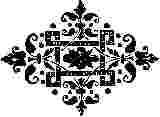
Part II
"Elders" in the Bible
"Elders" in Israel were the guides and directors of
the nation.
In Numbers 11:16 we read:
"Gather unto me seventy men of the elders of Israel, whom thou knowest to
be elders of the people, and officers over them."
These were selected to assist Moses in judging and governing the
people. We notice these elders wore no crowns.
"Elders" in the New Testament represent teachers and
general overseers of the flock of God.
These were to be spiritual guides in the ecclesias. These also have no
crowns. The exception to this was a few brethren at Corinth to whom Paul wrote,
"Now ye are full, now ye are rich, ye have reigned as kings without us:
and I would to God ye did reign, that we also might reign with you."
1 Corinthians 4:8, 9
This, however, was a fancied reign, and Paul was challenging its
propriety.
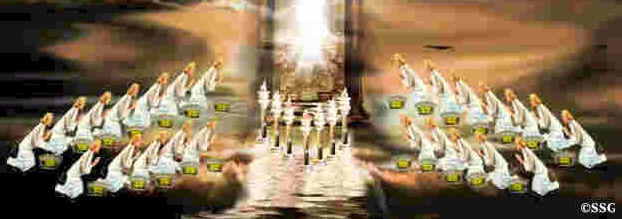 |
|
"And round
about the throne were four and twenty seats [thrones], and upon the seats I saw
four and twenty elders sitting, clothed in white raiment; and they had on their heads
crowns of gold." Revelation 4:4
|
These "elders" have "crowns" on their
heads. We see one central throne with twenty-four "seats" [thrones] surrounding
it. The central throne is God’s, surrounded by twenty four "thrones" in
God’s eternal purpose, together with the "four beasts" [living creatures]
and the "seven spirits of God." These "elders" are clothed in
"white raiment," showing righteousness.

1 Chronicles
13:11, 12
1 Chronicles
21:29, 30
David wanted to build a house for God. As he had built for himself a
wonderful dwelling on Zion’s hill, he felt uncomfortable with his luxurious
surroundings. David was sitting in the lap of luxury while the house of God wasn’t
even in its original tent.
Immediately, David decided he would build a house for God. 1 Chronicles
17:1-11 records this information which we will summarize briefly. David declared he would
build a house for God. Nathan, the prophet, encouraged David in his purpose.
That night the Lord spoke to Nathan to tell David, "You shall not
build me a house to dwell in." God further declared He would
build David a house. David started out wanting to be magnanimous toward God, and God
showed how exceedingly magnanimous He would be to David.
David had more trouble with the Tabernacle than he ever imagined he
would. He was full of good intentions, but not careful about details. In bringing up the
ark of God, disaster struck. Because they violated God’s law in bringing up the ark
on a cart, Uzzah died. We read,
"David was angry because the
Lord had broken out against Uzzah. ... And
David was afraid of God that day...." 1 Chronicles 13:11-12
(ESV)
"For the tabernacle of the Lord, which Moses had made in the wilderness,
and the altar of the burnt offering, were at that
time in the high place at
Gibeon;
"But David could not go before it to inquire of God: for he was afraid
because of the sword of the angel of the Lord." 1 Chronicles 21:29, 30
(ESV)
The Lord was angry with David for numbering the people and the Lord
broke forth upon Israel three days of pestilence. Finally, the Lord commanded the angel to
"put his sword again into the sheath" (1 Chronicles 21:27). It was not until
then that David could inquire of the Lord.
Despite the setbacks, David pursued his goal of building a house for
God. Since he could not build it directly, he gathered supplies, money and plans for his
son Solomon to build it. Additionally, he arranged for the services of the temple.
Because the temple would be a permanent structure, the Levites would
not need to assemble and disassemble it. In 1 Chronicles 23:28-30 new arrangements were
given by David. Of the Levites David said,
"Because their office was to wait on the sons of Aaron for service of the
house of the Lord, in the courts, and in the chambers, and in the purifying of all holy
things, and the work of the service of the house of God;
"Both for the shewbread, and for the fine flour for meat offering, and for
the unleavened cakes, and for that which is baked in the pan, and for that which is fried,
and for all manner of measure and size;
"And to stand every morning to thank and praise the Lord, and likewise at
even."
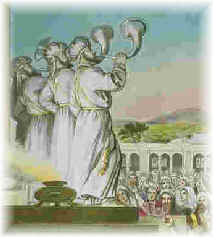
Solomon's Temple
|
So we see all the plans were formulated by David, not
Solomon.
That, of course, pleases us very much.

1 Chronicles 24:3, 4
In 1 Chronicles 24, David initiated a new arrangement for the
priesthood. Because Eleazar had sixteen sons and Ithamar had eight sons, the priests
were organized by lot. They divided the priesthood into twenty-four courses to serve in
rotation for one week while their special assignments were determined by lot.
Each course appears to have commenced its work on the Sabbath, the
outgoing priests taking the morning sacrifice, and leaving the evening sacrifices to the
next course of priests.
(2 Chronicles 23:8)
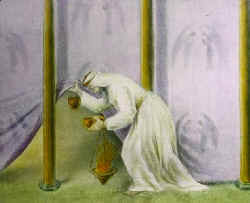
The Levitical Priesthood |
This arrangement continued up until the time of Zechariah, the father of John the Baptist.
We read in Luke 1:8, 9:
"Now while he was serving as priest before God
when his division was on duty, according to the custom of the priesthood."
(ESV) |
This proves David’s plan was put into practice
and continued until the Temple was destroyed. Remember, David created these offices before
there was a temple.

1 Chronicles 25
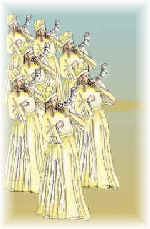
Twenty-four Courses
of the Priesthood
|
In 1 Chronicles 25 the Levites were divided into twenty-four courses to provide singing
and music in conjunction with the services of the temple.
Asaph, from one of the Levitical families, was apparently very talented
in music and Psalms 50, 73-83 bear his name.
We see that as there were twenty-four courses of the priesthood who
served in rotation for one week, their counterparts among the Levites also served in
similar manner.
Certain Levites were chosen to provide music and singing during the
temple services on a similar basis.
These twenty-four courses of Levites may represent the Great
Company who will serve God day and night before the throne.
|

David Is Divinely Instructed
in the Plan for the Temple
and Courses of Priests and Levites
David was Divinely instructed in regard to the temple construction,
as well as in ordering the courses of Priests and Levites. When David gave Solomon the
plans for the temple and its services, it was not on his whim.
In 1 Chronicles 28:11-18 David conveys all the plans of the temple and
its services. In 1 Chronicles 28:19 we read:
|
"All this, said David, the
Lord made me understand in writing by his hand upon me, even all the works of this
pattern."
God, therefore, visited David and engraved these details and plans upon
his mind. This was very much like what the Lord did to Moses.
|

King David
|
The Lord revealed the Tabernacle details to Moses in
Mt. Sinai whereas 1 Chronicles 28:19 made it clear "the Lord made me understand in
writing." God was totally involved here. David was Divinely guided. Read again 1
Chronicles 28:11-19 to get the whole picture.
We read in 2 Chronicles 29:25:
"And he set the Levites in the house of the Lord … according to the
commandment of David, and of Gad the king’s seer, and Nathan the prophet: for so was
the commandment of the Lord by his prophets."
This information is often overlooked and some think that David did
this of his own volition.

"Twenty-four Elders,"
"Thrones" and "Crowns"
Twenty-four "elders," we believe, represent the
twenty-four courses of the Priesthood of God. As they appear in this vision, they were
only the foreordained "elders." They existed only in the mind and purpose of
God. God speaks of those things which are not as though they were.
(Rom. 4:17)
The twenty-four "thrones" or "seats" show that
these "elders" were called to occupy God’s chosen offices
The twenty-four "crowns" (apparently one crown to an office)
showed the "elders" not only have the offices, but also the "crown" or
authority to fulfill their offices.

Why Twenty-four "Elders"
and Not Twenty-four "Priests"?
Our study would have been made easier if Revelation had referred to
"twenty-four priests" instead of "twenty-four elders." In fact, the
words are quite the same in meaning.
According to the New World Dictionary the word priest derives from the
Greek word presbys, which means old or elder. So a priest is, in essence, an
"elder." Now both titles embody the thought of personhood. Only men served as
"elders," and only men served as "priests."
The first significant body of "elders" were collected to help
Moses judge the people. The matters that were too hard for them to decide were then
referred to Moses.
Later the Sanhedrin, composed of seventy to seventy-two members, was a
judicial body at the time of our Lord. Peloubet’s describes them thus:
"It consisted of chief priests, or the head of the twenty-four classes into which the
priests were divided, elders, men of age and experience, and scribes, lawyers, or those
learned in the Jewish law."
Each of these twenty-four courses had one head or "chief
priest," so there were twenty-four "chief priests."
Also, we notice a variation in the length of time Levites served in the
Tabernacle. They were limited to the ages of thirty to fifty in (Numbers 4:3),
twenty-five and upward in (Numbers 8:24), and twenty
years and upward in (1 Chronicles 23:24). The
difference of the starting ages seems to have been tied to the severity of the service. As
the work lessened, the age for beginning service lowered.
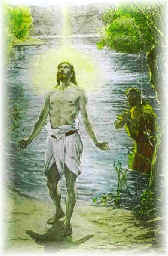
|
While this
age limitation did not apply to Aaron and his sons, we know that Jesus consecrated at
Jordan at age thirty.
The High Priest was to hold office for life (Numbers 35:25), but Annas
was deposed by the capricious act of the Roman procurator.
However, in Israel he was still regarded as the High Priest even though
Caiaphas was actually serving in that office.
|
After retirement priests entered into
the higher role of statesmen, judges, spiritual guides and wise counselors, supposedly
represented in the Sanhedrin. The twenty-four "elders" pictured not the
sacrificing priesthood of this age, but the glorified and retired sacrificial priests who
will function as "elders" and "statesmen," God’s ultimate role
for them. In essence, the twenty-four "elders" would be a kingly priesthood
after the order of Melchisedec.
Click to go to the following:
Topical
Study on:
"Casting Down Golden Crowns" Part I - Part II - Part III - Part IV
Chapter/Verse by Verse Study on:
Revelation 4
Topical Study Home Page - Chapter Study Home Page
- Sinaitic Manuscript - Questions - Glossary.
E-Mail
Day7000@sbcglobal.net with comments.
Copyright 2001 John Class
|